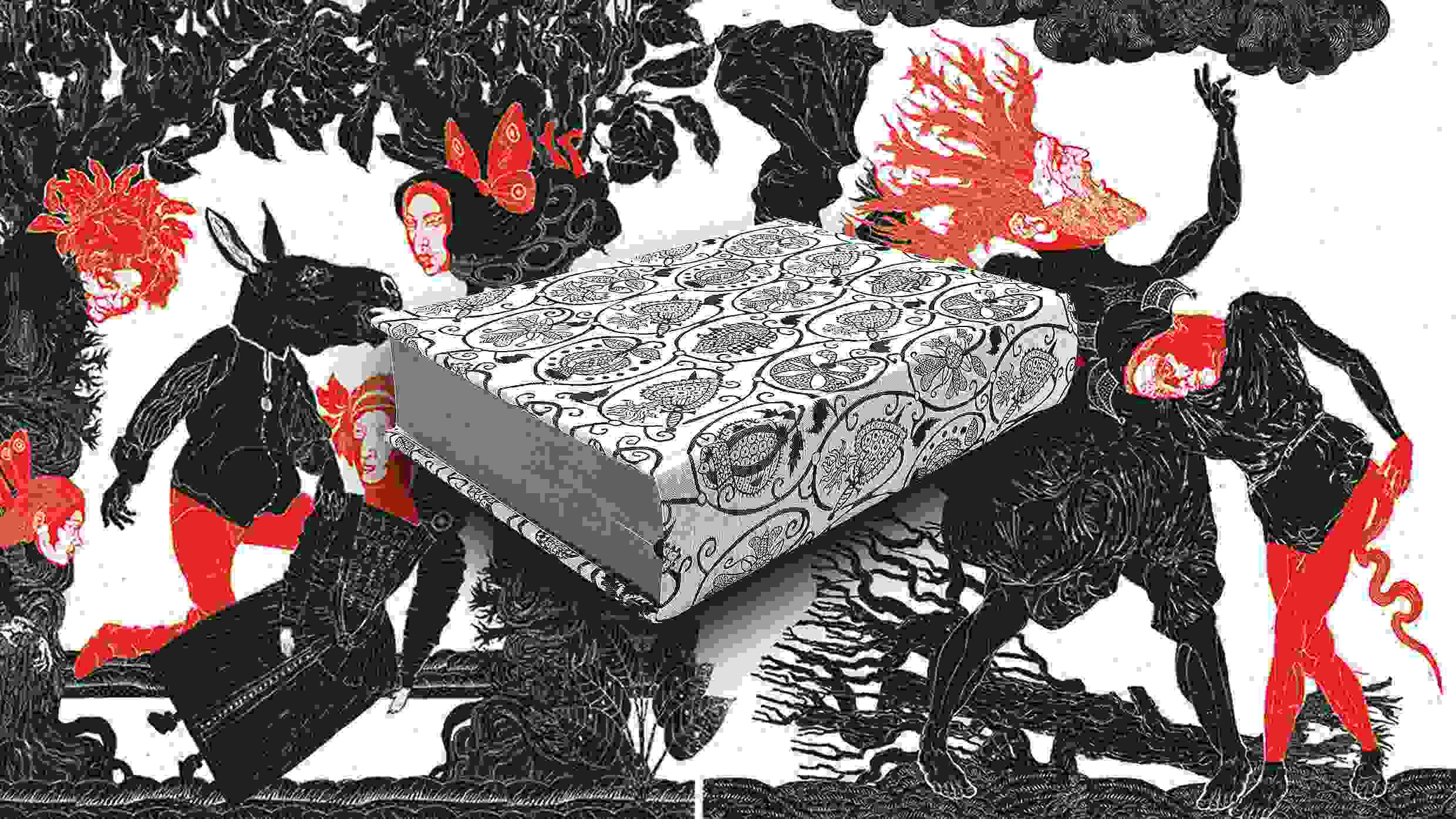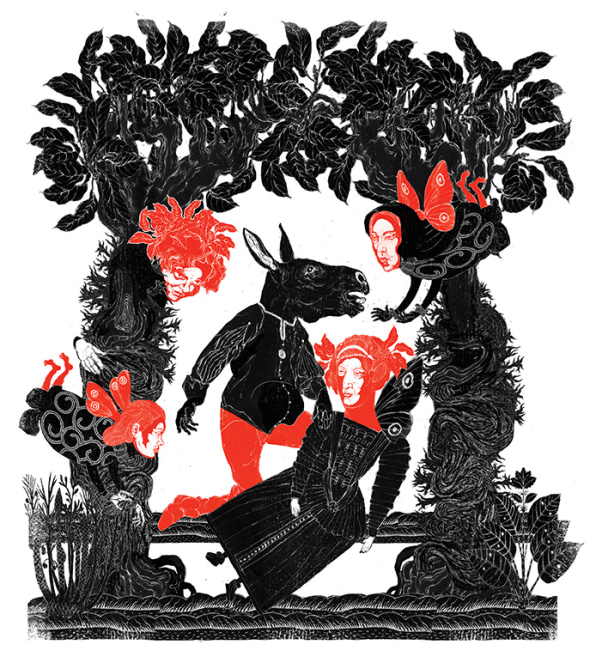- | 9:00 am
What this $1,500 book tells us about the future of modern publishing
The Folio Society makes the world’s most expensive and lavishly designed books. Its bet on beauty is paying off.

Endless gold foil-stamping over richly textured cloth. Midnight-blue endpapers. Full-color illustrations. An abstract slipcase adorned with impressionist work by artist Dave McKean.
This isn’t erotica—it’s a special edition of Neil Gaiman’s American Gods—but for book lovers, there’s something almost pornographic about the output of The Folio Society. To the delight of obsessive fans and collectors, the British direct-to-consumer publisher produces over-the-top illustrated editions of classics, pop fiction, history, and everything in between.
In an era defined by publishing industry layoffs, the business ravages of the COVID-19 pandemic, our dominant disposable culture, the need to produce books cheaply to drive better margins, the prevalence of ebooks, the long-forecasted “death of print,” and *gestures broadly* all the other hallmarks of the publishing industry in the 21st century, The Folio Society shouldn’t work. Or to put it more bluntly, if you proposed a business plan for an operation similar to The Folio Society to a group of investors today, you’d probably be laughed out of the room.
But it does work.
As The Folio Society prepares to launch its most elaborate book yet this fall—a reproduction of Shakespeare’s First Folio to celebrate the 400th anniversary of its publication—we were curious as to how the company pulls it off. As it turns out, its plan may be an anachronism, but it has proven to be a damn good one.
When The Folio Society launched in 1947 in the wake of World War II austerity, its founder, Charles Ede, sought to create “editions of the world’s great literature, in a format worthy of the contents, at a price within the reach of everyman.” It was set up as a member’s-only book club requiring four purchases a year, and it continued that way until 2011, when the Society cracked the door open on sales to the general public. Current CEO Joanna Reynolds joined the company around eight years ago after a career in media. At the time, the organization was still operating with that hybrid model, though it was only marketing its offerings to members, and spending the majority of its energy retaining them.
Moreover, “You could only sign up in September,” Reynolds says with a laugh. “Don’t go there. Just don’t go there. It was bizarre.”
One of the first things she did was pull the plug on the membership model. The move has proved transformative for the business. Crucially, it allowed her team to overhaul the larger publishing program. In 2016, Reynolds says Folio’s audience was white men over 60. For years, Folio’s output had trended toward smaller and smaller esoteric markets, so they broadened their reach into new spaces.
They studied the data and delved into fanbases for work like A Game of Thrones, Hitchhiker’s Guide to the Galaxy, and Marvel Comics properties, while simultaneously staying true to hallmarks of literary fiction and classics. They focused on the notion of gifting—a critical part of their business today—and strategically deployed catalogs to fans, who took the opportunity to make a book lover’s day during the holidays.
Given that the brand operates as DTC and is not in any stores, it emerged from the pandemic in a growth pattern—especially in the U.S., which is now Folio’s biggest market after a push to center efforts in the country around five or six years ago. The editorial team also wanted to bring more diversity to their operation, both in terms of the books they were producing and the people who were illustrating and creating them.
The efforts have not only redefined their audience—now 25 to 65, across an even split of those who identify as male or female—but Reynolds says that after losing money for a decade, the business began turning a profit four years ago, and now is an operation of around £15 million.
The one that has not changed in spite of it all: the way they create books. And that’s the key to everything.
“It is craft, artisanal, slow bookmaking,” says publishing director Tom Walker. “That’s what we do. We’re very, very lucky that we’re able to do that. That’s why people love us.”
Over the years, Folio has produced a three-tiered leather-bound edition of The Divine Comedy, loaded with illustrations by Neil Packer, an essay by Jhumpa Lahiri, and stunning hand-drawn quotations printed on the edges of the pages. They released a charming Tale of Peter Rabbit set with historic facsimiles, “charting the transformation from Peter’s initial appearance in a picture letter to the glorious full-color deluxe first commercial edition.” The aforementioned Hitchhiker’s Guide spans five metallic-foiled volumes that mosaic together to form a single cosmic image (a surprise towel is included in the $875 price).
While these limited editions—which often sell out within hours or days—are where Folio truly stuns, every single book they publish is bespoke. The Society releases about 50 volumes a year in initial runs of 2,000 or so, and all are illustrated to varying degrees.
“There are lots of different ways of making something completely extraordinary,” Walker says. “Fundamentally, we’re trying to make the edition that a true lover of that book would consider to be their perfect edition.”
And it’s not just readers. Writers do, too: Stephen Fry has declared that “a Folio Society edition is, I reckon, as excellent an accolade as any author can achieve these days.”
Moreover, “Neil Gaiman considers his edition of American Gods to be the definitive version,” Walker says. “Margaret Atwood considers her edition of Handmaid’s Tale to be the definitive edition. George Martin called Game of Thrones ‘a masterpiece of the bookmakers’ art.’”
Were Shakespeare alive, he would perhaps agree.

While the production of each book is distinct, Walker and his team’s work on the First Folio offers a porthole into the lengths they go to produce something remarkable. Given that the plays have been passed down for centuries in varying permutations, the team devoted considerable editorial research and energy to presenting the most accurate original text. They commissioned Judi Dench for an essay to contextualize the set. Walker says Packer spent “a year, pretty much nonstop” on the illustrations. Folio’s production director has been working with a shop that has a 300-year-old Huguenot Weaver to produce the silken cloth for the three-volume edition. The publisher wanted everything to be created in the U.K. to honor the playwright, so the books are being printed in Yorkshire and bound nearby, complete with a hot letterpress label created in Stroud.

Like all Folio books, the binding is sewn instead of glued (a key to longevity) and printed on high-quality paper that resists yellowing.
The set is three years in the making—which is not an unusual timeline for the publisher. It’s something that is ultimately reflected in the price. The costs of Folio books vary wildly, with some smaller titles coming in around $37, some novels in the $65 to $75 range, slipcased tomes like American Gods around $140, and limited editions ranging everywhere from $150 to, in the case of the First Folio, $1,500. Not exactly “at a price within the reach of everyman”—but within the reach of those who prioritize fandoms in their budgets.
Reynolds was initially nervous for Folio’s books to be listed in the Google Shopping results alongside much-cheaper mainstream versions—but it has turned out to be a successful sales tool for the publisher. Ultimately, fanbases are willing to plunk down more for the verified object quality at play—and the passion at Folio that inspired it. Reynolds and Walker say that, more than anything, that passion is what guides their list, and any one of the company’s 40 employees can suggest a book to produce, and do.
“You need someone within Folio to really care about it, to be that fan, to be the person who takes on Game of Thrones and says it’s wonderful what the illustrator has done, but what we really need here is all of the family trees,” Walker says. “It’s those tiny little details that I think would get missed in a more commercially orientated environment.”
A year and a half ago, Folio became an employee-owned trust, with everyone splitting profits equally regardless of their position—and Reynolds says it has only fueled her team’s passion and sense of pride in their work even more.
Ultimately, Folio may be an anomaly in publishing today. But everything that makes it one is why it works. When discussing the role of books in culture today, Walker cites all of those aforementioned fatiguing elements of the industry—ebooks, cheaply produced mass market titles—as the top reason a reader would want a spectacular edition of their favorite book.
“The more digital the world gets, the more people go back towards these slow book movements,” he says.
In fact: “I really think that we’re going through a golden age in book design.”
Let the good times roll.





































